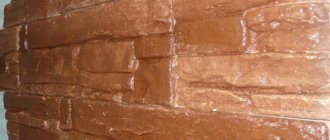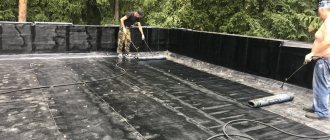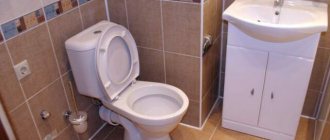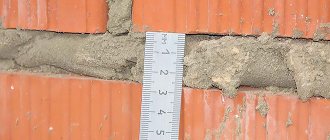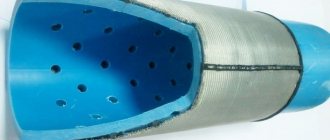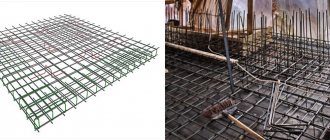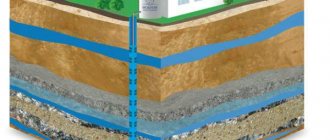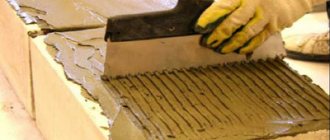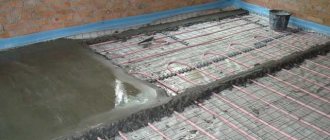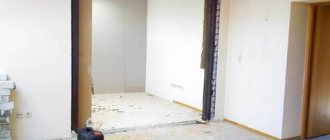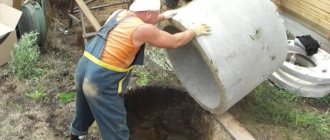The quality and reliability of the finished brickwork depends directly on what mortar you choose and how you implement the thickness of the seam in the brickwork - longitudinal and vertical. This value must be set at the very beginning, each row must be carefully monitored and checked by measuring the height of the area every 5-6 levels.
If you deviate from the recommended parameters, you will have a significant overconsumption of the composition, weak connections between the blocks will appear, which will affect the rapid destruction of the building in the future. The decrease in strength is due to the fact that additional compressive and bending loads occur. Moreover, uneven removal of moisture from the connecting mixtures occurs, which is not allowed. So, the thickness of the joint in brickwork is a very important parameter.
What are the standard requirements?
On average, the recommended value for the thickness of a brickwork joint according to SNiP is 10 mm. More precise parameters can be selected based on the type of bricks you use, as well as the type of structure. If there are significant deviations downwards, workers will not be able to compensate for possible unevenness in the ceramic products used, and the calculated number of blocks may not be enough. If the thickness of the joint in the brickwork is greater than the recommended parameters, the resulting building will be less durable than necessary.
The parameters specified in the standard are considered relevant if you use ordinary components to build a supporting system. In brickwork, the thickness of the horizontal joint should be approximately 12 mm, and the vertical joint - 10 mm. The permissible limit for longitudinal rows will be from 10 to 15 mm, and transverse seams vary from 8 to 12 mm. Deviation from the stated project parameters is not allowed. It is very important to carefully monitor and check quality at all stages of work.
Joining options
Joining gives the structure a finished look and is carried out upon completion of the masonry. The work is painstaking and requires careful execution from a specialist.
The jointing serves to protect the mortar and brick from moisture penetration through existing cracks and irregularities. For better adhesion, special components are added to the solution. The seam between the bricks, the size of which corresponds to the standards, is embroidered with a special tool. Its use allows you to carry out work more clearly and accurately.
There are several types of jointing:
- Convex and concave
- To trim
- Pustoshovka
- Single-cut
- Double-cut concave and double-cut convex.
The paneling of the front side of the wall has its own differences. Depending on the design, the seam is made full or incomplete, with a recess of up to 15 mm. An incomplete seam promotes better plastering of the surface.
The convex shape of the seam protects the masonry from the effects of precipitation. If the climate is drier, the seam is made more concave.
The original design is considered to be a panel made in black or white. Its contrast with brick makes the appearance of the building more attractive.
With the help of jointing, masonry is updated to renovate the facades of old houses with unplastered brick walls. To do this, you must first deepen the existing seams by 2-3 mm and apply new mastic. If the work is done carefully, the masonry will have the appearance of being freshly laid. A recess is made in the old mortar using a chisel.
What affects the thickness and uniformity of the seam?
Professional training of the employee. Due to the increased requirements regarding the reliability of a structure made from a small piece block, the work should be trusted only to qualified, highly specialized specialists. It is best to hire experienced teams.
The hardness of the solution and the selected preparation method. If you place elements tightly, you need to use a thick, high-percentage mixture based on cement and sand. The maximum permissible thickness of a brickwork joint in this case will be 12 mm. If you use more liquid and plastic compositions, then you need to lay the products as closely as possible. The distance between adjacent elements should not exceed 8-10 mm.
Accuracy of shapes and sizes
In comparison with aerated concrete blocks, which are placed on a layer of construction adhesive of 2-3 cm, brick is much more difficult to lay, because deviations from standard values need to be constantly corrected. If you use cheap and uneven elements, masons will have to adjust the thickness of the mortar joint in the brickwork in individual courses by a few millimeters to fit the entire wall to the design plan.
This factor is decisive. Only a professional team can make gentle adjustments to a product that has an incorrect shape or size. In case of large deviations, the strength of the structures will be reduced by up to 25%.
Reinforcement is unlikely to help in such a situation. To reduce risks, the material must be carefully checked before purchase. In addition to the thickness of the mortar, the reliability of the brickwork is also greatly influenced by the strength grade of the bricks, the proportion of voids and resistance to severe frosts. The influence of the thickness of joints in brickwork is very high. This parameter must be taken into account together with geometric accuracy.
The importance of dressing during construction of a structure
The safety of a building structure depends on its correct construction. Conventional masonry is carried out using the long side of the material, this method is called spoons, the short side and across the wall are called pokes. Construction begins with raising the corners several bricks higher than the usual structure. The layer formed between the masonry is adjusted, and the excess is removed before the solution hardens. Afterwards the jointing is carried out.
Main rules:
- When erecting a building, it is necessary to check the laying of corners with a square at least twice throughout 1 m of masonry.
- Check the horizontality of the rows (with a rule and a level), and the verticality of the surface of the corners (with a rule with a plumb line).
- It is better to align the ones that arise with the next row.
- The thickness of the solution between the material should be measured every 5-6 rows.
If the established parameters are not observed, the structure will not be strong enough. Proper jointing ensures the building's resistance to external factors.
Permissible deviations
This rule is relevant for various small-piece components, as well as for facing and silicate ones. A slight increase in the thickness of the masonry joint of brickwork is considered acceptable when working with double varieties, however, in general, during the construction of load-bearing structures and facing masonry, the interlayer must be maintained within 10 mm for a vertical joint and 12 mm for a longitudinal one.
An exception is fireboxes for high-temperature furnaces and similar structures made of refractories. In such cases, it is necessary to apply 5 mm of a special solution.
A separate group is tiles with a rectangular shape. It must be installed in compliance with the recommended jointing standards, which in turn depends on the texture and type of cut of the products, as well as requirements regarding protection from moisture.
Recommendations for laying different types of bricks
Load-bearing walls and a basement in an area that is often exposed to moisture must be built from solid ceramic bricks. Most often they are of a single type. An effective scheme in this case would be a two-row one. After all, it makes it possible to evenly distribute the weight load. The final thickness will be 25 cm. Products are best installed after carefully checking the evenness, as well as after waterproofing the base. It is advisable to inspect them for damage to rule out errors. The first row must be placed without using dry mortar, and all unformatted blocks must be removed.
The thickness of the vertical joint in the brickwork of the lower layer can be 20 mm, however, all further layers must be laid taking into account the design data. A small amount of the compound should be applied to the bonded side of the brick, and then slightly pressed against the previously installed blocks.
Excess mixture in the longitudinal direction must be removed using a trowel. Perform smooth movements from bottom to top. When making horizontal rows, be careful as there is a risk of spreading the mixture along the surface. This is especially important if you are working with face brick. A special template will help you get uniform thickness without much overspending. If you do not have experience, then you need to use the template not only in longitudinal, but also in transverse directions.
How to strengthen the mortar joint between bricks?
The solution is old and crumbling. You can secure it somehow.
There are many different ways, but try my, dare I say it, recipe. Initially, of course, clean the seam from any crumbs of old mortar. Then make a new mortar (cement/sand = 3: 1), and most importantly, the highlight of the method, add construction PVA to it (for 1 bucket of mortar, 1 liter (kg) of PVA glue). And before preparing the solution, simply coat the cleaned seam with glue twice (the interval between coats is at least an hour), after which you can apply the solution to the cleaned seams, naturally removing the excess. It will hold strong!
In my opinion, it is necessary to first assess the whole situation as a whole.
The bricks of the entire masonry are laid on the same mortar, the mortar is not strong, very serious work (restoration) to strengthen it may be needed.
There may be a solution in the seams, it simply crumbles, in this case it is enough to buy a deep penetration primer, “Yunis”, “Optimist”, “Ceresit”, etc., any of them will cope with the task.
Primer “Ceresit ST 17” is available in the “winter” version (if there is a need to perform work at low temperatures).![][1 ]
Using a thin brush (no wider than the masonry joints), apply primer to the joints and dry them.
Such primers penetrate deeply into the base, strengthening it, and the seam will definitely not crumble (crumble).
If the mortar is partially or completely absent from the seams (spilled out), then prepare a mortar, cement + sand 1:3 (cement M500).
Next, we clean the seams from the remnants of the old mortar, which does not adhere well to them, prime the seams (see above), dry them and fill them with new mortar, and you can also unstitch the seams.
The work is, of course, very labor-intensive, I think that there is a point in such work if the building is of some historical value.
If not, then it is simpler, more logical and correct, to plaster the surface with leveling plaster and finish with decorative plaster (as an option).
It all starts in the corner
The construction of any structure must begin from the corner with further strengthening of the order. This is a special bar to control the level. Walls that need to be plastered or insulated must be erected with staging. You will recess the mortar 15mm deep from the face of your masonry.
Once you have checked the level and made careful adjustments if necessary, the elements can no longer be moved until setting begins. After completing several rows, we recommend taking a short break.
The quality of thermal insulation is a decisive factor
A multi-row heat-insulating system must be installed using porous ceramics, which have a fairly high strength grade. The general standards for joint thickness in brickwork and its differences do not change. However, due to the fact that there are voids, be prepared for the fact that you will need to increase the consumption of the solution.
The change will also affect its composition, in order to eliminate cold bridges; to the standard mixture, which is mixed in proportions of 1 to 3, it is necessary to add components that reduce thermal conductivity. This can be expanded clay chips, foam glass and other analogues. The scheme for multi-row structures becomes very complicated, so if you doubt your abilities, it is best to hire a team of specialists.
Ceramic pressed and sand-lime bricks must be laid in the same way as others - from the corner. Carefully monitor the level and ensure that each row is placed dry. Due to increased requirements regarding decorativeness, the type of seam will also change: it will be concave or convex. Grouting must be done without delay. The second type is most often chosen during façade cladding. After all, such jointing helps to strengthen the protection of walls from moisture.
Seal seams in brickwork
The painted facade of a brick house often hides unfilled seams between the bricks. The reason for such defects is the insufficient amount of cement mortar when laying bricks.
Often such a defect becomes noticeable only when, under the influence of atmospheric phenomena, the plaster falls off and unclosed seams between the bricks become visible.
If the damage is isolated, the defect can be easily eliminated by filling the seams with new mortar. To do this, use a screwdriver or chisel to remove all pieces of old mortar in the seams. Just don't push them inside. Then wet the bricks, since dry brick absorbs a significant amount of moisture from the mortar, and only then, having prepared and cleaned the space in the masonry joints, fill them with new mortar.
The new solution must be thick and contain a minimum amount of water, otherwise it will easily leak out of the joints. First of all, you should fill the vertical seams, followed by the horizontal ones. Fill the seams all the way in and press flush. The solution should set well over the entire surface of the joints.
Closer to the outer wall, the solution should be drier than for the internal space of the seam. The seams should be embroidered in such a way that they do not differ in shape and structure from the rest of the wall. We recommend using a piece of hose along with a trowel to join the seams. The seams are leveled especially carefully if the wall must have an absolutely flat surface.
At the end of the repair, remove any remaining mortar, pieces of gravel, etc. After drying, scrape off excess mortar.
1. Visible holes in the masonry. It is necessary to check the neighboring areas to see if there are any unfilled seams.
2. Remove any loose cement with a chisel, but do not push it inward.
3. A stream of water washes away the remnants of the old mortar and wets the surface of the bricks.
4. Using formwork, you can prevent the solution from crumbling.
5. Compact the mortar into the seams using a narrow trowel, supporting it with a regular trowel.
6. Smooth out the mortar in the seams with a piece of hose.
7. Whiten the treated areas with a soft roller.
Tools:
A paint roller, two trowels - a narrow one and a wide one, a piece of hose, a scraper, an old screwdriver or chisel, a brush and a water hose.
Follow the face tiles
A nuance is the placement of small holes for ventilation in the vertical seams. As a rule, this is done every fourth row. During operation, the front surface must be protected from contact with the solution. If drops do accidentally get in, remove them with a dry cloth before they set.
Requirements for masonry and grout mixtures may vary depending on their water saturation. Standard ceramic mixtures must be moistened before installation; clinker mixtures are laid dry, but only with a special composition that contains a minimum amount of substances that draw out salts.
Seam dimensions in brickwork according to SNiP
- Sizes and types of bricks
- Factors that affect seams
- Types of seams
- SNiP requirements
- Technological features of masonry
- Joining
By measuring the thickness of the seam, you can visually determine the quality of construction of any structure, regardless of whether it is a commercial or residential building. If you do not maintain the level distance between building stones, this not only worsens the appearance and attractiveness of the structure, but also causes a decrease in its reliability. Therefore, every mason must constantly monitor the thickness of the seams during the construction stage. This can be done either by measuring with a ruler or visually.
Sizes and types of bricks
Any masonry brick is made from a clay composition using different technologies, but this does not affect the strength of the structure. The strength of any masonry is influenced by the presence of voids inside the stone. In this case, the solution can penetrate inside the brick and provide it with more reliable adhesion to the base. Depending on this it can be:
- hollow;
- full-bodied.
Solid stone is used for finishing chimneys and fireplaces, and hollow stone can be used when laying partitions. Regardless of the type of brick, its length and width are standard - 250 and 120 mm, and the height may vary. Therefore, the size of the seams must be chosen depending on the width of the stone itself.
Factors that affect seams
First of all, this depends on the consistency of the solution, which can spread to the sides when pressure is applied from above. Experts note that the optimal seam thickness is 10–15 mm in the horizontal plane, and vertical seams should be made on average 10 mm. If double bricks are used, the seams should be made 15 mm.
You can control these dimensions by eye, but you can also use crosses or metal rods of a certain thickness. All these dimensions are determined by SNiP, and compliance with standards is influenced by the training of the employee himself. Therefore, when laying building facades or decorative structures, it is recommended to give preference to professionals who can prepare the mortar in accordance with the requirements, adding the required amount of sand or other components to it in order to maintain the thickness of the masonry within the required limits.
Climatic conditions and subsequent operation of the object during brickwork are of particular importance. If masonry is carried out at low temperatures, it is recommended to add special additives to the solution. In this case, the seams should be kept minimal, which makes it possible to reduce the influence of negative factors on the solution and make the masonry monolithic.
According to GOST, a small deviation from the specified seam values is also permissible, but the deviations should not be more than 3 mm, sometimes 5 mm is acceptable.
Types of seams
Today you can find the following types of seams:
- pruning;
- single-cut;
- wasteland;
- convex;
- double-cut.
SNiP requirements
All building stones that are used in the construction of structures must be selected in accordance with the standards for various types of building materials, which is also determined by SNiP. The brick used for external masonry must have a rectangular shape and clear edges. Each building stone is visually inspected by a master before laying.
It is also important to properly prepare the solution, which should have a mobility of no more than 7 cm. To ensure such parameters, it may be necessary to add various components to the cement mixture, including plasticizers, lime and chemical additives. These components are added depending on the manufacturer's requirements.
In winter, it is recommended to keep the solution temperature at least +25 degrees. If conditions do not allow maintaining this temperature, then it is necessary to add plasticizers to the solution.
SNiP also determines that the use of building stones that do not have the appropriate certificates is prohibited, especially in the construction of residential buildings.
Technological features of masonry
These points are also regulated by GOST, therefore all construction work must be carried out in accordance with the projects and carried out by qualified masons, depending on their category. Any masonry is regulated by SNiP according to the order of work.
- Marking space for the wall.
- Defining openings for doors and windows.
- Setting up orders.
When constructing a multi-storey building, work is carried out in stages, and after the first floor has been forced out, the ceiling is done. Next, the internal walls are erected and, if necessary, reinforced.
The tool used must be reliable and meet technical specifications, as well as be in working condition. When performing work, you must strictly comply with the safety requirements of SNiP. If the building is high-rise, then all workers must have special belts for working at height. All masons working with material supply must have slinger certificates and communicate with each other to ensure coordinated work. There should be no foreign objects at the site that will interfere with the work.
Joining
Joining, which is done after laying the brick, also plays an important role in ensuring the finished appearance of the structure. It comes in a variety of types and prevents water from penetrating into the brick and mortar, which increases the life of the building. The distance between the bricks is widened using special devices, which allows you to form a clear seam. If necessary, special components are added to the solutions to increase adhesion. After jointing, such a structure takes on a more attractive appearance.
The work of jointing itself is painstaking and requires a certain skill from the worker. At the last stage, it is necessary to constantly monitor the size of the joints and adherence to technological regimes depending on the masonry element.
The construction of any structure begins by laying out the corners with securing the order, which is a special bar for adjusting the level of the masonry. If the wall will be insulated in the future or finished with other materials, then it is necessary to embed the mortar between the bricks so that it does not protrude outward. After erecting the corners, it is necessary to make adjustments so that in the future the walls will not have slopes. It is also recommended to build several rows of bricks at once, giving the mortar time to set so that it does not affect the geometry of the wall.
You will learn how to make the perfect brickwork joint in the video below.

